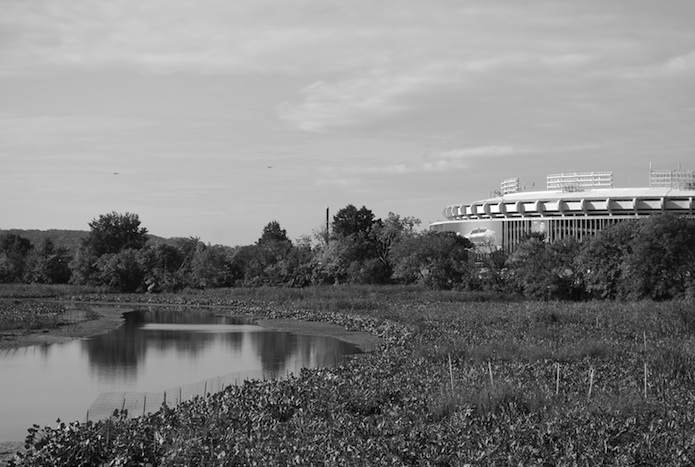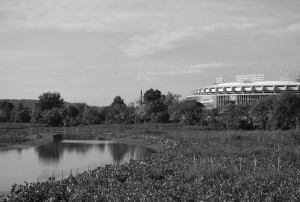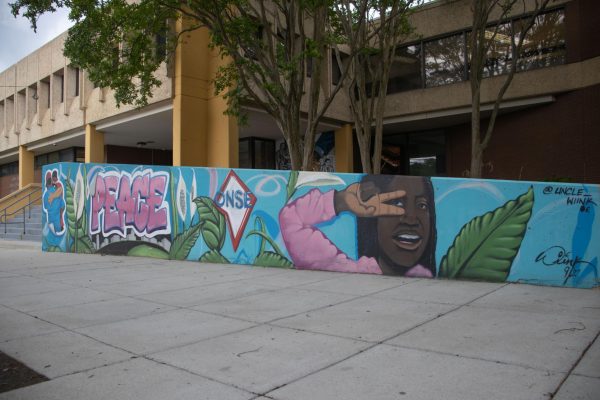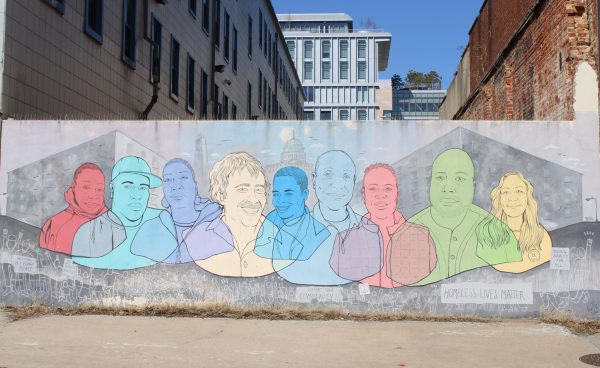Reversing a Century of Neglect on the Anacostia
National Children’s Island would become a DC landmark—our very own Coney Island. Its developers promised 6,000 visitors every day.
My photographer and I meet Daniel Rauch, a wildlife biologist with the District Department of Environment. Equipped with binoculars and a clipboard, Rauch is counting birds.
“When I was hired, I thought I’d be counting pigeons and swallows,” Rauch says. But the DDOE has identified 150 bird species on two islands that might have been home to roller coasters and arcades.
To get to Kingman and Heritage Islands, we cross a vast parking lot. Semi-trucks and city vehicles sit empty below an elevated Blue Line Metro track. We walk across a wooden footbridge, where an area resident is fishing with his grandchildren.
I ask them if they know this area was almost turned into an amusement park. The grandfather tells me he wishes they had. He gestures to his grandson, “Not him, though, he’s more of a nature type.”
Fifteen-year-old Stephen tells me he has been coming here for almost eight years. Back then, he tells me, there was no entrance. He discovered the islands by pushing his bike through a line of trees. Now, he and his friends ride their bikes up and down the islands.
“Do you know about psionics?” he asks. “In two weeks, I can give you methods to train your mind to influence the world around you.” Perhaps sensing my skepticism, he went on. “I have the ability to read energies. This place has very strong energies from a lot of different people.”
Creating the Islands
The Army Corps of Engineers created Kingman and Heritage Islands in 1916. Back then, the Anacostia was a shallow, muddy river bordered by extensive marshland. Engineers lifted sediment from the bottom and dumped it in the marshes to combat malaria and open the river for shipping. In the process, they created 46 acres of dry land.
Over the next 90 years, many developers came forward with plans for the island. In the 1930s, it might have been a recreation center, complete with an ice rink and swimming pool. In the 1940s, it was to become an airport, serving something called the National Skyway. In the 1980s, it was briefly considered for a federal prison.
The name “National Children’s Island” came about in the late 1960s. That plan would have ushered in the bicentennial with several playgrounds, a museum, library, petting zoo and carousel. Meant to open on July 4, 1976, construction never began due to tight budgets and ballooning estimates.
In 1991, then-Redskins owner Jack Cooke had plans to create a parking lot for a brand new stadium next to RFK. The DC Council allowed him to pave over 19 acres on the site, but plans fell through.
National Children’s Island was reborn when Contessa Bina Sella di Monteluce, a European philanthropist, raised $6 million to form the Island Development Corporation. The Island Development Corporation contracted with Washington, DC in 1993. In 1995, Congress approved the transfer of the islands from the federal government to DC.
Local groups like the Anacostia Wildlife Corporation and the Earth Conservation Corps worried about its impact on the environment and on the stability of the surrounding community.
“No one would propose a theme park for Rock Creek Park or Theodore Roosevelt Island! Why do they target the Anacostia?” read one anti-development flier. A large segment of the community wanted to reclaim the island as parkland.
Others wondered whether DC was getting a raw deal. By hurriedly handing control of the islands to a private developer, the city would lose out on money that could include a share of parking or admissions fees. Proponents of the plan claimed the project would create as many as 2,400 jobs and generate millions of dollars in sales tax revenue.
In response to these objections, former Mayor Marion Barry negotiated a 99-year lease with developers, which the DC Council approved with a 7-6 vote. “The kids of Washington are going to enjoy this park,” said Barry in a Washington Post article from 1997. “The land over there is fallow, with nothing but snakes and rubbish on it.”
Just as it appeared that something would be built on these two islands, the DC Financial Control Board nullified the lease. Once again, the islands were thrown into uncertainty.
A Haven For Secrets
Lofty plans for airports, theme parks and stadiums obscure what actually took place on Kingman and Heritage Island: nothing.
The island became a dump site, a refuge for the homeless and a part of local folklore. In 1941, a Washington Post headline read, “Hungry Wild Dog Devours Kingman Lake Squatter.” Later that month, a follow-up article detailed an expedition to catch the “wolf-like dog whose master’s bones were found on the island Friday.”
Stories circulated about Joseph Malone, a “modern Robinson Crusoe” who for more than six years lived in a makeshift campsite on Kingman Island’s southern tip. When renovations to the island began in the early 2000s, about a dozen homeless people had made Kingman Island into a permanent home.
“We used to talk to one of them,” said John Dillow, executive director of Living Classrooms, the non-profit that took over management of the islands in 2007. “He used to say he had the best view on the island…and it was true.”
While the island has undergone many renovations, rumors about its history persist.
“Back in the ‘80s there used to be big crime and drug wars going on, so rival drug gangs used to meet out here and dispute over turf,” Dillow said. “Apparently the bridge was set on fire to stop that connection.”
During the controversy over National Children’s Island, rumors spread that the Island Development Corporation wanted to introduce riverboat gambling to the Anacostia.
Cleaning Up Anacostia
Anecdotes aside, Kingman and Heritage Islands, and the Anacostia River as a whole, are coming out of a century of abuse. Not by evil developers or big corporations, but bad planning, weak regulations, racism and apathy.
“People would clean up an alley and literally dump it here,” said Dillow. “The people who used it the most were the park police, who would do all their helicopter training on the island.”
Other than occasional police raids to evacuate squatters, the island was forgotten. The last bald eagles in the District of Columbia abandoned their nests on Kingman Island in 1946.
“From my perspective, it’s not a legacy of controversy, it’s a legacy of neglect,” said Uwe Brandes, former vice president of the Anacostia Waterfront Corporation. For three years, Brandes oversaw the implementation of the Anacostia Waterfront Initiative, a $10 billion plan to clean up the Anacostia River and promote sustainable development on the waterfront.
Pollution on the Anacostia River comes mostly from storm drain and sewer runoff. A third of the District is served by a system that combines sanitary sewers and storm drains. When those sewers reach capacity—as they often do during heavy rains—a mixture of rainwater, street runoff and sewage pour out of outfalls over the Anacostia. Along with trash dumping and lingering industrial pollutants, the river is a toxic place to swim and fish.
“The river also contains a surprisingly high amount of animal waste,” said Brent Bolin, a spokesman for the Anacostia Watershed Society. Barges used to carry waste from the National Zoo to a riverfront dumping site where the National Arboretum is today. “Now they package that stuff up and sell it as fertilizer,” Bolin said.
The Watershed Society, founded in 1989, was among the first to work on cleaning up the river. Bolin told me that its goals remain much the same today.
“Right now the river is sort of seen with a stigma,” said Bolin. “We’re focused on cleaning up the river and bringing people to the river.”
One of the Society’s first projects was the Anacostia Community Boathouse. The boathouse hosts local crew teams, including American University’s team.
Earth Conservation Corps, another non-profit, is housed in a former steam-pumping station down the street from Nationals Ballpark.
“Our founder, Bob Nixon, found this building when it was buried by a mound of trash,” said Kellie Bolinder, the interim executive director of Earth Conservation Corps. With the help of Navy Seabees, Earth Conservation Corps’s first project was to redo the pumping stations.
Earth Conservation Corps hires unemployed youth from Southeast DC to clean up the riverfront and promote conservation in the community.
Earth Conservation Corps graduate Raynard Smith remembers pulling 5,000 tires out of Lower Beaver Dam Creek in one day. “People find cars, playground sets,” said Smith. “There’s a lot of stuff that shouldn’t be in the river that’s in the river right now.”
DC hopes to open the Anacostia for swimming and fishing by 2032. “Baptisms used to take place in this river,” said Bolinder. “People in the grandparent generation can say, ‘I swam in this river, I fished in this river when I was a kid.’”
Today, swimming in the Anacostia is illegal. Fish caught in the river are high in bacteria and heavy metals. The National Fish and Wildlife Service estimates that two-thirds of Anacostia catfish have cancerous lesions. Bolin described the subsistence fishing that still takes place. “Starve to death today, or die in 10 years.”
Despite warnings, swimming still goes on. “Every day in July I’d see someone swimming in this river,” said Bolin. In June, local politicians and activists wore Tyvek suits—which look like biohazard suits—and jumped into the river, taking care to keep their heads above water.
Clean or not, the tide is turning. People want to use this river.
Seeing the Islands
Kingman and Heritage Islands are at the center of the Anacostia clean-up effort. In 2002, DC Mayor Anthony Williams launched his campaign with a boat ride in Kingman Lake. After a court battle freed the city from its commitment to National Children’s Island, a new plan could take shape.
For the first time since the islands were built, that plan is being executed. A community-driven voting process has finally paved the road to consensus. Plans are in place for new trails and a LEED platinum certified environmental education center. The first phase of trail improvements was completed last month.
In 2007, the city handed management responsibility to a Baltimore-based non-profit called Living Classrooms. Founded in 1985, Living Classrooms brings school groups, summer camps and families to Kingman Island and other natural areas around DC.
Over the last three years, 1,700 students have learned about ecology on Kingman and Heritage Islands, and 5,000 volunteers have contributed almost 40,000 hours toward cleaning up the island. The park sees over 1,000 visitors every month.
An Uncertain Future
It takes about 20 minutes to walk from one end of Kingman Island to the other. Start at the north end, where the busy Benning Road separates you from Langston Golf Course (one of the first to allow black golfers). The National Park Service owns the Langston Golf Course, which takes up the northern half of Kingman Island.
Walk south past a community garden and a construction trailer. Peering into the thick maples, you can see hints of the failed beginnings of other projects and occasional pieces of Styrofoam debris. Further down the trail, a lone dumpster sits in an overgrown lot.
Keep walking past decorative boulders and patches of fresh cement. Walk below the graffiti-ridden underside of the East Capitol Street Bridge and emerge in a sunny garden, where you find benches, birdhouses and a backhoe.
Signs of the islands’ future outweigh its neglected past. From the bridge between the islands, you can spot great blue herons fishing in the muddy expanse of Kingman Lake. Walking the trail that loops around Heritage Island, the sight of stadiums, bridges and parking lots disappears. The thick trees teem with chirping birds and insects. On a lucky day, you may see a bald eagle in the sky. Since 1992, the Earth Conservation Corps has gradually reintroduced the species to the river.
John Dillow, the executive director of Living Classrooms, speaks excitedly about plans for canoe portages, boardwalks and river overlooks. Plans for the centerpiece of the restoration project, the environmental education center, were drawn up in 2005. The building is expected to cost at least $20 million. In 2009, architectural plans won an American Institute of Architects award for “Best Unbuilt Building” in the DC area.
“It’s a very cool building, a very expensive building,” said Dillow. “If someone showed up with a check it could easily become phase one.” Until that happens, Living Classrooms and the DC government are saving Kingman and Hertigage Islands by letting them remain natural spaces.
“You come here and you’re like, ‘I’m literally a couple miles from the Capitol,’” said Dillow. “And you think, ‘This is a pretty cool place.’”
Photos by Jess Keane










